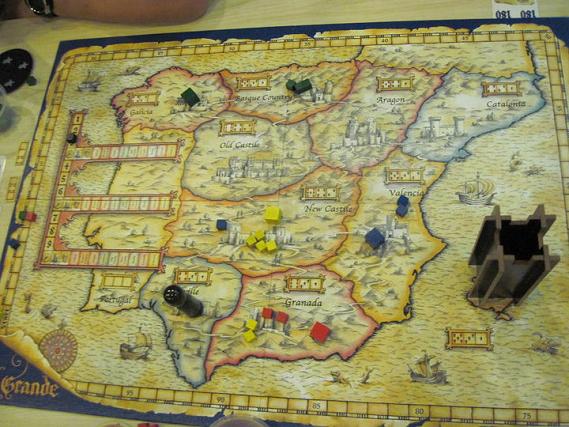4 Aug

Strangely enough, the board has an ancient parchment look that fits with its reputation as a classic area control game.
Once again, as Hiew has written a complete description of the game’s rules and an account of our session, I’m not going to cover the same ground. I’ll just skip straight to my thoughts. Note that this is with the Intrigue and King expansion. I’ve never played the El Grande basic game and don’t even know how it works.
- This is another euro in which the theme doesn’t really seem relevant at all. In this case, even the pieces, artwork and board don’t really tell you what it’s supposed to be about. It doesn’t help that the choice of setting isn’t a familiar one. Who has even heard of Spanish cowboys?
- The game itself however is fantastic. I understand that it has a glowing reputation as an area majority game. As far as I can tell, that reputation is fully deserved. What’s particularly interesting to me is that many of the area majority games I’ve played have a very strong tactical focus with little long-term strategic planning involved. I think that El Grande rewards both deft tactical maneuvering as well as keeping an eye on longer-term goals.
- I wasn’t happy with how I played the game at all because I didn’t fully understand the implications of all the rules until the game was nearly over. I really admire how Hiew and Sean can go through the rules of any given game once and instantly know the consequences and values of different moves and options. I think I really need to replay more stuff rather than try new ones all the time.
- One handicap I had to contend with was that I had selected my initial hand of cards poorly. Due to the limitations imposed by the King piece on where caballero pieces can and can’t be played, regions changed hands less often than I thought they would compared to the other area majority games I’ve played. I had kept in my hand cards that caused regions worth a certain number of points to be scored even though I controlled no such regions at the beginning of the game. I simply assumed that it would be relatively simple to temporarily gain control of them later. Even worse, these were some of the highest numbered cards I had. Since it was extremely disadvantageous for me to play these cards and I lacked other high numbered cards, I tended to have lots of pieces in my supply but few ways to get them onto the table. For the same reason, I had few opportunities to move the King piece during the session.
- I didn’t fully grasp the implications of the Castillo either. Its five points make it quite valuable in of itself, but most importantly, pieces thrown into it were basically doing double duty as you can use them later to control another area on the board and even allow a bending of the normal placement rules as you can target a region that’s not adjacent to the King. Still, considering how aggressively both Sean and Hiew tried to control it, it was probably best that I mostly kept out of that particular contest.
- I was happy to be assigned New Castille at the beginning of the game. Boy, was I dumb. Yes, it’s worth a lot of points, but it’s also in a central location that is likely to be adjacent to wherever the King piece is placed in very often. But Sean and Hiew mostly left me alone and left Shan and me to fight over it. This makes meta-gaming sense as both of them understood that their real opponents would be each other. I think this intuition is something my wife still lacks even though she’s improved tremendously as a boardgame player since we first started.
- The variety of card effects are quite a lot to take in. There’s even a veto power that can apparently cancel just about anything. I’d bet this gives El Grande a lot of longevity that other games in the genre can’t match. Over time, different players might even come to develop different sets of favorite cards and the ways to use them.
- Hiew commented that he generally isn’t a fan of area majority games. In my case, I tend to do very badly at them but I quite admire them. One quirk about this genre is that, unlike most other euro games, they allow direct conflict between players. You certainly can’t call them multi-player solitaires. To me, this makes the genre very computationally intense. You’re not just figuring out how best to gain points for yourself. You also need to figure out who to pour the pressure on and how hard. I guess this is exactly the sort of thing that can cause sore feelings among friends and some people might not like that.

Caballero cubes and the infamously phallic King piece in the background.
Written on August 4 2010 and is filed under Boardgames.
You can follow any responses to this entry through the RSS 2.0 feed.
You can leave a response, or trackback from your own site.
2 Responses to “El Grande: Intrigue and King”
Area majority games is Euro-style War games… in an abstract ways.
Trackbacks
Leave a Reply